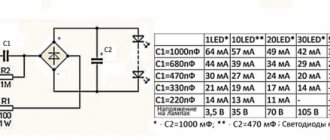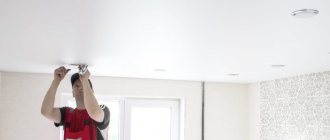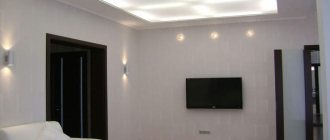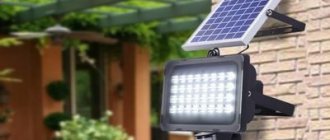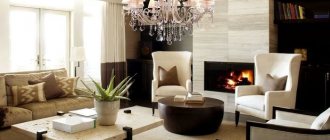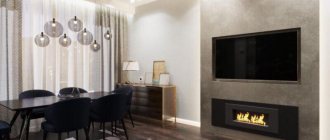It would seem that with the abundance of goods that is observed today, the choice of lamps for the home does not present any difficulties. You just need to decide on the desired design, and then open the online store page, or personally visit the shopping center. However, the task only seems simple. As soon as it comes to implementing plans, most buyers are simply lost.
What does this look like in practice? Seemingly endless shelves with lamps, chandeliers suspended from the ceiling, obscure information on price tags. The situation is a little better with online stores. At least there are convenient filters and quite clear photographs. And a huge minus is that the buyer cannot “touch” the selected model, evaluate its appearance and dimensions. In addition, not every buyer has an idea about the functionality of chandeliers and their features. People simply don't know what to pay attention to. After all, the appearance of the lamp is not the only important parameter. So buying lighting fixtures for your home turns into something like a lottery: you’ll be lucky or unlucky.
The question arises: how to act correctly? People with some experience, as well as professional designers, are never limited by the appearance of the lamp. They take into account a lot of details and nuances, including the purpose of the device, the location of its installation and the tasks that it will perform. Today we will tell you how to choose the right household lamps for all occasions.
Determining the lighting level
It is known that vision problems, loss of energy and constant migraines can occur due to poor lighting in the room.
The lack of light also negatively affects a person’s psychological state, so calculating the lighting level is the most important step in the process of choosing a lamp.
There are a lot of programs on the Internet that allow you to calculate an indicator acceptable for a particular room, for example Dialux. However, you can calculate the lighting level manually using a special formula.
This formula is based on the ratio of the total luminous flux of lighting devices and the area of the room, taking into account the correction factor.
The calculation looks like this: E (lx) = F (lm) / S (sq. m) × η, where:
- the calculated indicator E represents the level of illumination of the room, calculated in Lux;
- F is brightness measured in Lumens (you can find its value on the packaging);
- S – area of the room for which the calculation is being made;
- η is a correction factor that reflects the proportion of light reaching from the lighting device to the working surface.
A correction factor is necessary to make the calculation more accurate.
Otherwise, the formula will not take into account the fact that not all the light from the lighting device reaches the target, but is partially scattered, falling on the walls, ceiling or furnishings.
The average value of this indicator is 0.5.
The indicator obtained during the calculation process must be compared with the standards for indoor lighting, which are prescribed in special standards.
In particular, the indicative figures are indicated in SanPiN 2.21/2.1.1/1278-03 “Hygienic requirements for natural, artificial and combined lighting of residential and public buildings”, as well as in SP 52.13330.2011 “Natural and artificial lighting”.
According to them, the lighting level must comply with the following standards depending on the type of room:
- bedroom and living room – up to 150 lux;
- children's room - 200 lux;
- office or room intended for reading – 300 lux;
- bathroom, toilet – 50 lux.
As for office premises with computer equipment installed in them, according to the standards, the lighting level in them should be about 400 lux.
However, it is also permissible to use lamps with higher brightness, because most manufacturers indicate on the packaging not accurate, but inflated data regarding the value of the luminous flux.
Which ones are better
The best lamp should:
- consume little electricity;
- have no power outages;
- be positioned correctly according to the height of the room;
- be functional, used for its intended purpose and illuminate the required space;
- have the required strength and brightness of light;
- be easy to use and maintain;
- be made of durable and safe material;
- suit the room in size, radiation intensity, color and style, fit into the overall design.
Organization of lighting zones and power selection
Before moving directly to choosing a lamp, you need to think about the design of the lighting area.
If you think in time about for what specific purposes this or that lighting device is needed, you will be able to avoid mistakes.
Design project by Kiril Ognenov
If you want to decorate any area in the apartment with the help of light, then you need to think through its design down to the smallest detail from the very beginning. In this case, both the color of the walls and accent furnishings will be important.
For example, if you hang a picture on the wall in a sitting corner, it would be advisable to highlight it with light.
And in this case, the lighting should be as soft as possible, not irritating the eye, and the color of the sconce should not contrast with the shade of the walls.
Then the area highlighted with the help of proper lighting will look organic, both on its own and in the general space of the apartment.
As for power, here it is also necessary to proceed from the tasks that need to be solved with the help of lighting. For example, the lamp power in the workplace should not be higher than 60 W.
On the one hand, high values of this indicator guarantee increased brightness of the light, on the other hand, such lighting can negatively affect a person’s well-being during long and intense work.
To decorate a small workspace, it is advisable to choose lamps with soft, diffused light that will not strain the eyes.
It is better if it is lighting as close as possible to daylight. Larger work surfaces will require more powerful lighting fixtures, but the degree of incandescence must be taken into account.
When designing a work area, it is also important how the lamp will be installed. In this case, the lamp should not peek out from under the lampshade or be at eye level.
How they work
The lamp consists of a lamp and auxiliary elements that drive the mechanism: a starter and a throttle.
- The starter is a neon lamp with two bimetallic electrodes. Voltage is applied to the lamp, a discharge is formed in it, after which the starter elements are closed. A strong current passes between the lamp bulb and the starter electrodes.
Then the electrodes open the system, and the voltage increases sharply through the inductor. Under the influence of voltage, the gas gap in the light bulb breaks through and it lights up.
- The choke is connected to the lamp in series, so the voltage is divided into both elements, the starter is connected in parallel, so the voltage is not enough to re-close the starter electrodes.
The choke limits the current after turning on the device and maintains stable operation of the lamp.
Selecting the size and design of the lamp
When choosing a lamp, both the size and design features of the lighting device are important. And here you need to take into account various nuances.
So, if the ceilings in the room are not too high, then it is better to abandon the use of an oversized high chandelier, replacing it with flat models of ceiling lamps.
Design project ARTEХ
At the same time, even a flat lamp should not be too small, otherwise it will not only not fully fulfill its lighting functions, but will also look awkward in the space of the room, making the interior unbalanced.
As for the placement of lamps in height, the average height above the floor should be 200-220 cm, the height of the lampshade above the table surface should not be less than 70 cm or exceed 90 cm.
Problems
Cons of chandeliers
- difficult installation;
- requires careful care;
- low security;
- large product sizes.
Problems with LED devices
- fragility;
- unpleasant spectrum of light;
- large in size;
- Operation requires expensive power supplies and cooling systems.
Cons of floor lamps
- illuminate a small space;
- potential flammability;
- there is no way to hide the wiring;
- dependence of the device on the outlet.
Disadvantages of sconces
- not used for main lighting;
- there is no way to hide the wiring;
- small luminous flux;
- Potential flammability.
Cons of floodlights
- difficulty in operation;
- burn out from overheating;
- high frequency flicker;
- high price.
Disadvantages of low-voltage lamps
- limited functionality;
- sensitivity to power outages;
- fragility.
Cons of night lights
- dim lighting;
- low color intensity;
- cannot be used as main lighting.
Disadvantages of busbars
- limited functionality;
- electrical current instability.
Selection of light bulbs
It is the type of lamp that determines how the lighting in the room will look. There are four types of lamps in total.
Incandescent lamp
This classic option has been used for lighting apartments for decades and has still not lost its relevance.
The light that comes from incandescent lamps is soft and warm, creating a cozy environment.
Compact fluorescent lamps (CFLs)
This option can be considered economical, because such lamps consume 75% less energy than traditional incandescent lamps.
In addition, they have an increased service life and cooler light. However, due to the mercury content, this lighting option requires careful handling and proper disposal.
LEDs
No less effective than the previous option, but their service life is three times longer.
They provide direct and too harsh light, therefore they are mainly suitable for workplace equipment.
Halogen
Another economical and bright option, consuming 15% less energy than incandescent lamps.
They emit white light, reminiscent of daylight. Suitable for equipping workplaces.
Appearance of light = Kelvin
When choosing a lamp, you need to consider not only its brightness, but also the color temperature of the light, which is measured in Kelvin and ranges from warm to cool.
Information about this characteristic can usually be found on the packaging. The higher the Kelvin value, the colder the light.
Soft white/warm white
The value in Kelvin is about 2,700. This light is more suitable for a living room or bedroom, where a cozy environment is of great importance.
Bright white/cool white
The value in Kelvin is early 4,100. This light will best fit into the interior of a kitchen, bathroom, or toilet.
Daylight
The value in Kelvin can vary between 5,000-6,000.
This light is more suitable for the dining room, kitchen, basement, library, study, where the maximum level of lighting is required.
Defining the lighting task
To choose the right lamp, you need to determine what type of lighting is required in a particular area of the room.
General or ambient lighting
This lighting is also called ambient lighting. Its main task is to uniformly provide light to the entire area of the room.
The most commonly used ambient lighting is ceiling-mounted lighting fixtures, such as chandeliers.
Work lighting
This type of lighting is necessary for arranging a workplace, for example, a computer desk, kitchen surfaces, or a sewing machine.
For these purposes, table or floor lamps are most often used, in which the angle of incidence of the light can be adjusted.
Design project from We Are Huntly Studio
Accent lighting
It is used to highlight individual objects in the interior, as well as for lighting in corridors, staircases, and hallways.
Wall lamps (sconces) are used as accent lighting fixtures.
There are also local and decorative lighting. The first is intended for zoning space and highlighting a separate zone in the room.
The second is temporary and is used as additional festive decoration of the room (garlands).
How to use it correctly
Recommendations for product care:
- To clean lamps, use special spray detergents. Before starting work, turn off the power supply and wait until the light bulb has cooled down.
Next, wrap the cartridge in waterproof material and cover the furniture and floor with newspapers. Spray detergents while being approximately 20 cm from the appliance.
- Second method: remove the lamp, disassemble it into parts and wash it. Antistatic wipes can be used for cleaning.
- To clean crystal products, first apply detergent to the surface of the crystal. When the water begins to drain, wipe the equipment dry. After 2 hours you can turn on the lamp.
- Wipe lampshades made of frosted or transparent glass with a damp sponge soaked in a detergent solution.
- Keep wooden, fabric and paper sconces away from fire sources. During repairs, do not forget to turn off the power supply.
Types of lamps
Before choosing a lamp, it is useful to know what types of lighting fixtures exist.
According to their design, lamps are divided into floor and table lamps.
Floor lamps
Floor lamps include a floor lamp, which is a universal lighting device for various types of rooms.
It is used not only for local illumination of any area in the room, but also as a decorative element.
Floor lighting fixtures can have a variety of designs, but most often they are made in the form of a lampshade on a high leg.
At the same time, in modern models the height and position of the leg can be adjusted, and the lampshade can be removed, which is very convenient.
Moreover, such a device does not require complex installation, but it is only suitable for highlighting individual zones.
Table lamps
Table lamps are mobile and compact portable structures on a leg with the ability to adjust the tilt, characterized by ease of use and low cost.
They are divided into working and decorative, and depending on the purpose, a number of corresponding requirements are put forward for such devices.
Pendant lamps
Ceiling lamps are classified as hanging fixtures. They are designed to highlight individual work areas and zoning space.
They can also be mounted at different heights.
Wall lights
Wall lamps include sconces that are mounted on the wall.
Most often they are used for accent lighting or highlighting individual areas in a large space.
Recessed luminaires
It most often includes spotlights (spots).
They are small lighting fixtures with directional light propagating at a certain angle and can be used in any room as an additional light source.
Interesting story
Lamps have never been perceived only as a functional item needed to illuminate a home. Their aesthetic value was no less important.
Man has long understood that the frame of the light source itself should be beautiful:
- Clay lamps in the shape of an elegant boat were presented by the East in the 3rd century BC.
- Bronze candelabras in the form of figurines depicting cupid, satyr or a female figure from Ancient Rome amaze even modern artists.
- Residents of Byzantium made bronze fire bowls, decorated them with crowns and hung them on powerful chains.
- Crystal chandeliers came from France. The stunning success was picked up throughout Europe, pendants and droplets of material sparkling in the light appeared. The word chandelier itself has penetrated many languages and is translated from French as shining.
- In the 15th century, Spain introduced the world to forged openwork lamps with flower buds made of metal.
- Floral motifs were picked up by Italian masters, adding rich images of fruit baskets made of Murano glass to the world's collection.
Modern manufacturers of lighting equipment do not forget their roots, rely on traditions, study and continue the work of their ancestors.
The most recognized brands in our time are deservedly considered: Elektrostandard, Eurosvet, Lightstar, Odeon Light, Italux, Nowodvorski and others.
Lighting for every room
When choosing a lamp, the type of room is no less important.
Bedroom
You should pay attention to pendant and ceiling fixtures, as well as additional lighting sources in the form of a wall sconce or a table lamp that can be placed on the bedside table.
Kitchen
In the kitchen area, not only ambient lighting is important, but also illumination of work surfaces and the dining area.
Lampshades, sconces, and built-in lamps are suitable for these purposes.
Living room
In a living room or hall you cannot do without a classic ceiling chandelier, designed for at least five lamps.
And as additional lighting, you can use accent light, for example, to highlight a painting or any designated area in the room.
Bathroom
Bathroom lighting can be quite complex and can involve different types of fixtures depending on the size of the room and its design.
However, there is one important rule: the mirror should be illuminated as much as possible on both sides.
Design project from Chango & Co
So, how to choose a lamp? You need to approach the choice of lighting in your home wisely, but at the same time creatively.
Sometimes the most unexpected lamp options fit perfectly into the interior and become its brightest element.
Therefore, when choosing a lighting device, you need to focus not only on the rules, but also on the general style of the room and your own preferences.
Chandelier in the living room: selecting it to match the interior
Chandelier in the living room with dark furniture
Dark furniture and a generally dark living room interior will reflect light worse than light surfaces. Therefore, it is better to choose a chandelier with a large number of shades (if the area allows). or complement a small chandelier with sconces, floor lamps, etc. From a decorative and practical point of view, a chandelier made of glass, crystal and metal parts is well suited to a dark living room. This model transmits and/or reflects daylight and artificial light.
TIP: In a large living room, lampshades looking down provide accent light, which is not enough for a spacious living room. And the horns directed to the sides and upwards, on the contrary, create general diffused lighting.
Classic pendant chandelier in a dark living room
Classic pendant chandelier in a dark living room
Chandelier in the living room with light furniture
In bright living rooms, a chandelier can support an overall calm palette or, conversely, be a bright element.
TIP: A chandelier with shades facing the walls expands the space. Therefore, they are perfect for small living rooms.
Classic pendant chandelier in a bright Scandinavian living room
Chandelier with shades pointing upward in a bright living room

